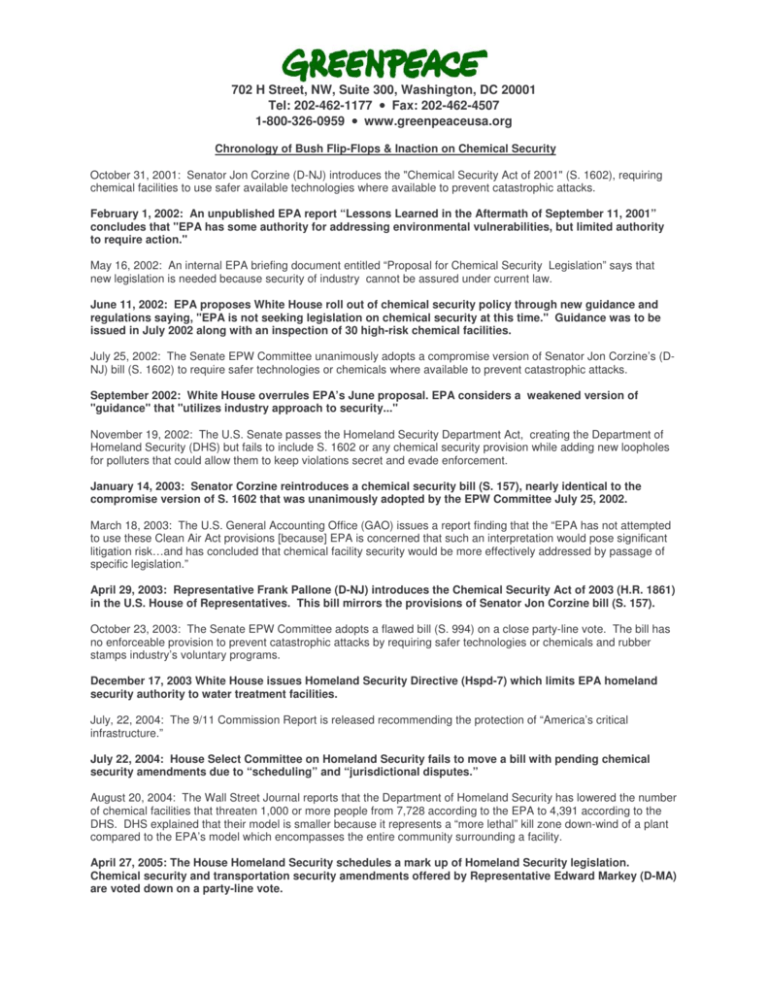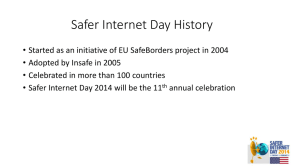702 H Street, NW, Suite 300, Washington, DC 20001 Tel: 202
advertisement

702 H Street, NW, Suite 300, Washington, DC 20001 Tel: 202-462-1177 • Fax: 202-462-4507 1-800-326-0959 • www.greenpeaceusa.org Chronology of Bush Flip-Flops & Inaction on Chemical Security October 31, 2001: Senator Jon Corzine (D-NJ) introduces the "Chemical Security Act of 2001" (S. 1602), requiring chemical facilities to use safer available technologies where available to prevent catastrophic attacks. February 1, 2002: An unpublished EPA report “Lessons Learned in the Aftermath of September 11, 2001” concludes that "EPA has some authority for addressing environmental vulnerabilities, but limited authority to require action." May 16, 2002: An internal EPA briefing document entitled “Proposal for Chemical Security Legislation” says that new legislation is needed because security of industry cannot be assured under current law. June 11, 2002: EPA proposes White House roll out of chemical security policy through new guidance and regulations saying, "EPA is not seeking legislation on chemical security at this time." Guidance was to be issued in July 2002 along with an inspection of 30 high-risk chemical facilities. July 25, 2002: The Senate EPW Committee unanimously adopts a compromise version of Senator Jon Corzine’s (DNJ) bill (S. 1602) to require safer technologies or chemicals where available to prevent catastrophic attacks. September 2002: White House overrules EPA’s June proposal. EPA considers a weakened version of "guidance" that "utilizes industry approach to security..." November 19, 2002: The U.S. Senate passes the Homeland Security Department Act, creating the Department of Homeland Security (DHS) but fails to include S. 1602 or any chemical security provision while adding new loopholes for polluters that could allow them to keep violations secret and evade enforcement. January 14, 2003: Senator Corzine reintroduces a chemical security bill (S. 157), nearly identical to the compromise version of S. 1602 that was unanimously adopted by the EPW Committee July 25, 2002. March 18, 2003: The U.S. General Accounting Office (GAO) issues a report finding that the “EPA has not attempted to use these Clean Air Act provisions [because] EPA is concerned that such an interpretation would pose significant litigation risk…and has concluded that chemical facility security would be more effectively addressed by passage of specific legislation.” April 29, 2003: Representative Frank Pallone (D-NJ) introduces the Chemical Security Act of 2003 (H.R. 1861) in the U.S. House of Representatives. This bill mirrors the provisions of Senator Jon Corzine bill (S. 157). October 23, 2003: The Senate EPW Committee adopts a flawed bill (S. 994) on a close party-line vote. The bill has no enforceable provision to prevent catastrophic attacks by requiring safer technologies or chemicals and rubber stamps industry’s voluntary programs. December 17, 2003 White House issues Homeland Security Directive (Hspd-7) which limits EPA homeland security authority to water treatment facilities. July, 22, 2004: The 9/11 Commission Report is released recommending the protection of “America’s critical infrastructure.” July 22, 2004: House Select Committee on Homeland Security fails to move a bill with pending chemical security amendments due to “scheduling” and “jurisdictional disputes.” August 20, 2004: The Wall Street Journal reports that the Department of Homeland Security has lowered the number of chemical facilities that threaten 1,000 or more people from 7,728 according to the EPA to 4,391 according to the DHS. DHS explained that their model is smaller because it represents a “more lethal” kill zone down-wind of a plant compared to the EPA’s model which encompasses the entire community surrounding a facility. April 27, 2005: The House Homeland Security schedules a mark up of Homeland Security legislation. Chemical security and transportation security amendments offered by Representative Edward Markey (D-MA) are voted down on a party-line vote. May 10, 2005: Representative Frank Pallone (D-NJ) introduces the “Chemical Security Act of 2005” (H.R. 2237) which requires EPA and the Department of Homeland Security to work together to identify "high priority" chemical facilities. Once identified, these facilities would be required to assess vulnerabilities and hazards, and then develop and implement a plan to improve security and use safer technologies within 18 months. June 15, 2005: At a hearing before the Senate Homeland Security and Government Affairs Committee the Bush administration claims to support the idea of legislation but provides no specifics similar to the scuttled 2002 EPA proposal. July 27, 2005: The Senate Homeland Security and Government Affairs Committee holds the last in a series of chemical security hearings. Committee Chair Senator Susan Collins (R-ME) commits to writing bi-partisan legislation over the August recess. December 19, 2005: Senator Collins introduces the Chemical Facility Anti-Terrorism Act of 2005 (S. 2145). The bill fails to require any safer technologies that could prevent catastrophic attacks on chemical facilities. Homeland Security Committee members such as Senators Joseph Lieberman (D-CT) and Frank Lautenberg (D-NJ) pledge to offer strengthening amendments. March 30, 2006: Senators Lautenberg (D-NJ), Obama (D-IL), Kerry (D-MA), Menendez (NJ), Durbin (D-IL), Biden (D-DE) introduces a broad chemical security bill (S. 2486) that requires safer technologies when feasible at chemical plants, protects state authority to adopt stronger protections, gives plant employees meaningful participation in security programs and ensures a role for the EPA in oversight of facilities. May 18, 2006: Senators Biden (D-DE), Jeffords (I-VT) and Boxer (D-CA) introduce the Community Water Treatment Hazards Reduction Act of 2006 (S. 2855) which requires high risk water facilities to identify safer technologies to eliminate hazards posed by the use of chlorine gas. The bill also authorizes $125 million a year over five years in grants to the highest risk facilities for capital costs needed to convert plants to safer technologies, including ultra-violet light, ozone or bleach. May 19, 2006: Senator Inhofe, chair of the Environment and Public Works Committee, schedules a Committee vote for May 23rd on his wastewater security bill (S. 2781). The bill will squander millions of dollars on outdated security measures instead of funding the elimination of hazards posed by chlorine gas through the use of safer technologies as recommended by a 2005 Government Accountability Office report. June 14-15 2006: Senate Homeland Security and Governmental Affairs Committee votes out weak chemical security legislation (S. 2145). Senator Voinovich (R-OH) proposes 14 weakening amendments. A Voinovich amendment to preempt states is rejected by a 9 to 7 vote. A Lieberman (D-CT) amendment to add costeffective safer technology requirements is rejected 11 to 5. June 21, 2006: Senator Inhofe (R-OK), chairman of the Environment and Public Works Committee, holds a hearing to attack safer technologies as a way to reduce or eliminate the consequences of a terrorist attack on a chemical facilities. Senator Biden (D-DE) testifies in favor of safer technologies as does Lisa Jackson, Commissioner of the New Jersey Department of Environmental Protection which administers a voluntary safer technologies program. July 11, 2006: House Subcommittee on Economic Security, Infrastructure Protection, and Cybersecurity of the Homeland Security Committee votes on H.R. 5695. On a party-line vote (10-8) the Subcommittee supports a provision to roll back any state and local security standards that are more protective than federal standards. By the same party-line vote (10-8) they reject an amendment to reduce the consequences of a terrorist attack through the use of safer methods or chemicals. July 28, 2006: House Homeland Security Committee completes mark up of H.R. 5695. The Committee embraces a compromise requiring the use of safer technologies at high priority facilities offered by Representative Markey (DMA). An amendment by Representative James Langevin (D-RI) improves the right of state and local governments to set stronger security standards but falls short of a similar provision in S. 2145. September 25, 2006: In a rush to show voters they have done “something” the Conference Committee on DHS Appropriations approved an unenforceable 3 year chemical security amendment supported by the chemical industry. October 4, 2006: President Bush signs temporary chemical security statute. December 22, 2006: The Bush DHS proposes new rules that assert DHS authority to prevent states from setting stronger security standards even though there is no such authority in the temporary law. The proposed rules also fail to require safer available chemicals or other technologies (IST) that can eliminate the magnitude of an attack. . April 2, 2007: Following many critical comments submitted by members of Congress (Republican and Democrat), labor and environmental organizations, the Bush DHS finalizes new regulations that continue to assert DHS authority to prevent states from setting stronger security standards than the federal government. The rules also fail to require safer available chemicals or other technologies (IST) that can eliminate the magnitude of an attack. June 12, 2007: President Bush threatened to veto a Department of Homeland Security (DHS) spending bill. Among their objections was “strong” opposition to a chemical plant security provision that would have restored the authority of states to set stronger security standards at chemical plants than the federal government. The chemical industry began lobbying for federal preemption to overrule state authority in 2005 when New Jersey announced stronger chemical security regulations. The bill was vetoed and the provision was eliminated in the final DHS spending bill. November 2, 2007: The Department of Homeland Security (DHS) widened loopholes in chemical facility reporting requirements that dramatically increased the amount of dangerous chemicals a plant can use or store without informing the DHS. The DHS is supposed to use these reports to determine which plants will be prioritized for new security regulations.







